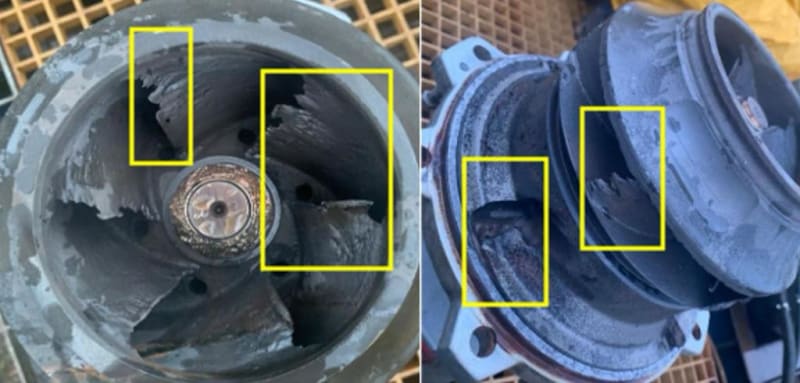Dear All,
We have four hot water circulation pumps, the details of which are below for your reference.
Hot water circulation pump specification: Data sheet: Suction pressure – 6 bar g; Discharge Pressure - 11.45 bar g; Flow rate – 200 m3/hr (30,191 bpd) and Temperature – 110 to 140⁰C, Viscosity (mm2/s): 0.22, Density (Kg/M3): 926
System Operating Parameters - Hot water/crude oil heat exchanger tubes side pressure inlet - 2.3 bar g /outlet – 1.6 bar g and shell side pressure inlet – 2.0 bar g /outlet pressure 1.2 bar; hot water circulation pump suction pressure - 1.2-1.5 bar g /discharge pressure – 5.0 bar g.
The pumps were running smoothly, on August 14th, we have added production chemicals (oxygen scavenger and neutralizer); after 70 days of running, we noticed a heavy loss of metal on the impeller and the first six inches of the discharge piping.
Please share your thoughts on this.
We have four hot water circulation pumps, the details of which are below for your reference.
Hot water circulation pump specification: Data sheet: Suction pressure – 6 bar g; Discharge Pressure - 11.45 bar g; Flow rate – 200 m3/hr (30,191 bpd) and Temperature – 110 to 140⁰C, Viscosity (mm2/s): 0.22, Density (Kg/M3): 926
System Operating Parameters - Hot water/crude oil heat exchanger tubes side pressure inlet - 2.3 bar g /outlet – 1.6 bar g and shell side pressure inlet – 2.0 bar g /outlet pressure 1.2 bar; hot water circulation pump suction pressure - 1.2-1.5 bar g /discharge pressure – 5.0 bar g.
The pumps were running smoothly, on August 14th, we have added production chemicals (oxygen scavenger and neutralizer); after 70 days of running, we noticed a heavy loss of metal on the impeller and the first six inches of the discharge piping.
Please share your thoughts on this.

